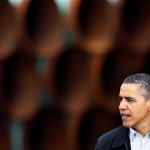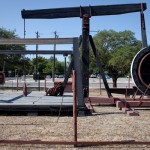Defending the Keystone XL Pipeline: Company Speaks Out

Photo by Flickr user Loozrboy/Creative Commons
The Keystone XL pipeline would take oil from sand pits in Canada to refineries in Texas.
It’s never out of the news for long. This week the Keystone XL Pipeline, a 1,700-mile, multi-billion dollar project that would connect the Alberta oil sand fields in Canada to refineries in Texas, has come back into the spotlight. There was maneuvering at the Capitol to override the President’s denial of the pipeline. In Texas, a farmer took out a restraining order against the company, TransCanada, after they used eminent domain to route the pipeline through her property.
TransCanada, a Canadian energy company, has been trying to get a permit for the pipeline for over three years. They’ve encountered environmental concerns in Nebraska and political wrangling at the highest levels of government. The project is currently delayed, but TransCanada says it will soon reapply for the permit it needs to build across the U.S.-Canada border.
We sat down recently to speak with Jim Prescott, a project representative for TransCanada, about the company’s views on the pipeline. He spoke of the advantages the company sees of building Keystone XL, the pipeline’s difficult permitting process and the inner workings of oil and gas transportation in America. (To read an opposing perspective on the pipeline, read our interview with David Weinberg of the Texas League of Conservation Voters.)
Q: Why is there a need to transport all these tar sand oils to America? Why can’t this oil just be refined up in Canada?
A: Well, they don’t have the refinery capacity up there, for one thing. The largest concentration of refineries in the world is from Corpus Christi, Texas to the Mississippi River along the Gulf Coast through Texas and Louisiana. So, this is where the demand is. This is where the refinery production capabilities exist.
Q: There are already a lot of pipelines crisscrossing the U.S. It’s not unusual to have new oil or natural gas pipelines from state to state. Did it surprise you to see how big of a national issue this has become?
A: I don’t know if surprise is the right way to say it.
To go back to your premise about the proliferation of pipelines, you’re correct there are a lot of pipelines. As a matter of fact, in Texas there are 170,000 miles of pipelines for natural gas and oil pipelines and there’s a reason for that. Pipelines are by far are the most efficient and safest way to move energy and in particular petroleum products…99.99 percent of oil and natural gas, delivered by pipeline in North America — delivered safely, delivered without incident or unplanned accident.
So when you compare pipelines in general, and look at a project like Keystone XL in particular, and ask is this something that we should do, the next question is: compared to what? Compared to rail? Compared to truck? Compared to tanker? If you look at pipelines in comparison to those three means of transportation, it’s actually not a fair competition. By far the safest way to move energy and oil in particular is by pipeline.
Q: President Obama denied TransCanada’s Keystone XL pipeline proposal. Many people think that was the end game for the project, but in reality it’s a lot more complicated than that. There are probably other proposals that will be back on the table soon, is that not correct?
A: That’s absolutely correct… TransCanada is looking at other options. Is it possible to build, for example, one phase of the project? For example, from Cushing, Oklahoma which is a hub, south all the way to the Gulf Coast, and do that separately without the presidential permit? Because, quite frankly, we need the presidential permit for about 50 feet of pipe right at the border between Canada and the United States. If we weren’t crossing that border, we probably wouldn’t be having this conversation.
Q: So why not build that pipeline from Cushing down to Texas or even from North Dakota further down south and just circumvent that international border crossing?
A: Those are good questions. And those are the answers we are trying to determine if we have good answers going forward. What’s feasible? Could we build from Cushing south to the Gulf Coast to relieve the bottleneck at Cushing? Could we build from Baker, Montana, which would pick up from the Bakken Oil Play in Montana and North Dakota? Which has huge production issues. Their problem up there at the Bakken is that that oil doesn’t have enough pipeline to get from the production field to market. So, they’ve got a bottleneck there. And then there’s a bottleneck at Cushing, Oklahoma to get oil south from Cushing to the Gulf Coast to the refineries in Texas and Louisiana.
Q: The oil that ends up at Cushing at that bottleneck, is that coming in by truck?
A: No, because we are already delivering to Cushing, that’s Phase 2 [part of the existing Keystone pipeline]. Cushing is an interesting component of the oil industry. It’s a significant hub of oil in the Midwest and when you hear about the price-point, the price of oil at W.T.I., West Texas Intermediate, that’s where it’s set. Based on the volumes and commercial mechanics of oil at Cushing. How much is in storage? Where’s it going? That’s the market place for it. The way the system works is that pipelines deliver oil to a central location, a holding area, a hub, Cushing or Patoka, Illinois, and as refineries need it they have their own pipelines back to their refineries and they draw it when they need it. It’s a very efficient way to move oil and it’s a very efficient way for those refineries to respond to changes in the market place.
Q: If there are already pipelines to and from Alberta and Cushing, what is the need the build another one?
A: The problem is, there is a glut of oil in Cushing right now. It’s a bottleneck, and it’s a bottleneck southbound out of Cushing down to the Gulf Coast. This would help alleviate that because this would be a steady supply of oil. In other words, we wouldn’t have to depend on the tankers that deliver oil through the Gulf of Mexico through their ports and then deliver it to their refineries. They could get it from Keystone XL. Keystone XL has the capability, based on volume, to replace on an annual basis, to replace 400 tankers a year. The implications and the impact of transporting oil from one side of the world to the other in 400 tankers. That’s a huge environmental impact. This pipeline replaces that.
Q: We’ve heard a lot about job creation potential. President Obama didn’t approve because they didn’t see a large job creation proposition or long-lasting job creation possibilities. What do you say about that position?
A: We’ve built two phases of this pipeline. We know exactly how many workers are needed. As a matter of fact, TransCanada has tried to answer that question because it’s one of the larger pieces of misinformation that opponents to the project continue to push. And they’ll dismiss these jobs as temporary jobs. This is what members of the union and the guys who build the pipeline, who are the best pipeline builders in the world, this is what they do for a living. They do this everyday and every year and this is how they support their family. So, I think is frankly something of an insult to those workers to just sweep aside those jobs as “temporary.”
Q: Anything else?
A: I’ll end with this, in terms of where we are at; we have acquired 97 percent of the easements in Texas, 99 percent in Oklahoma. So, we’re ready to go. We were ready to go a year ago, frankly, on this project.




